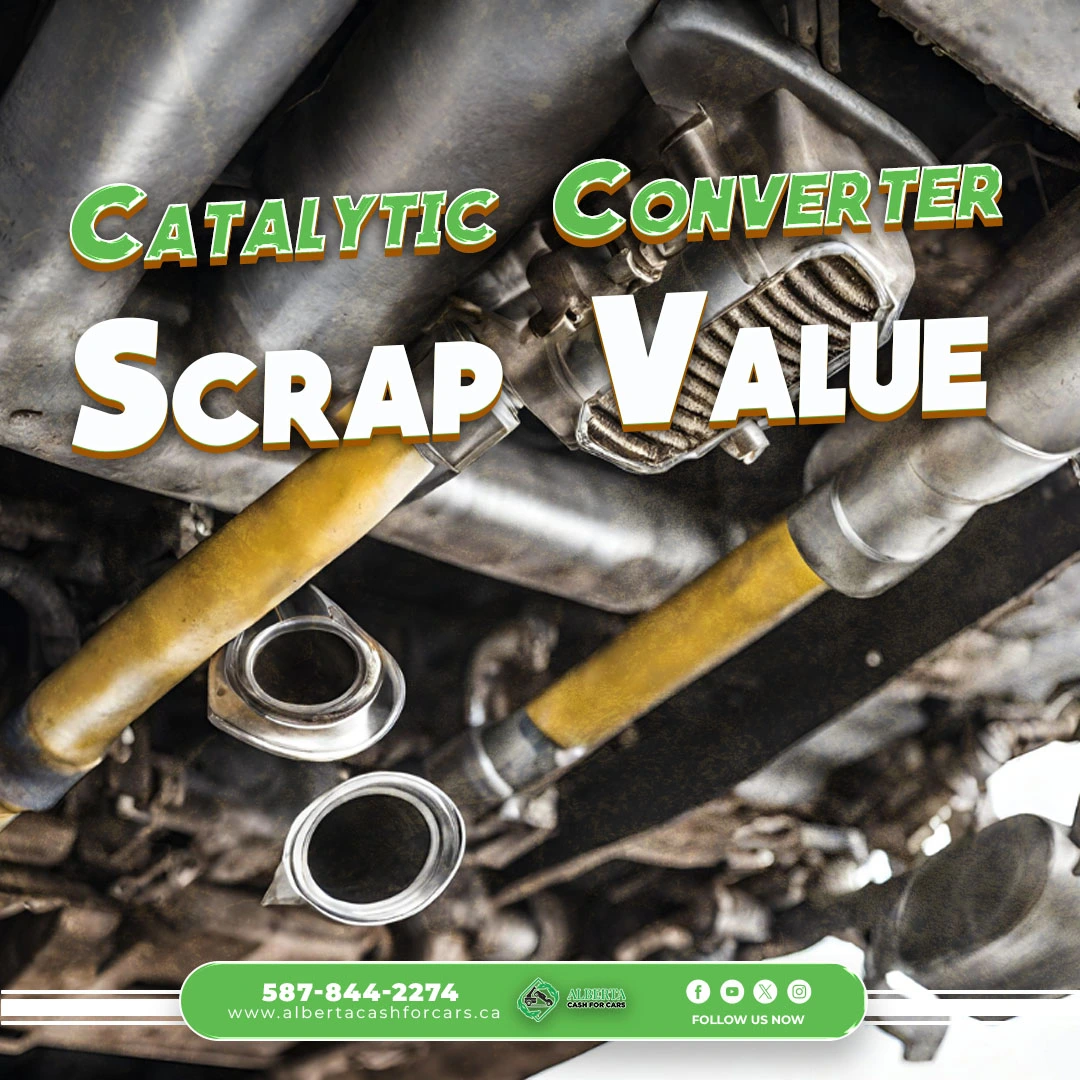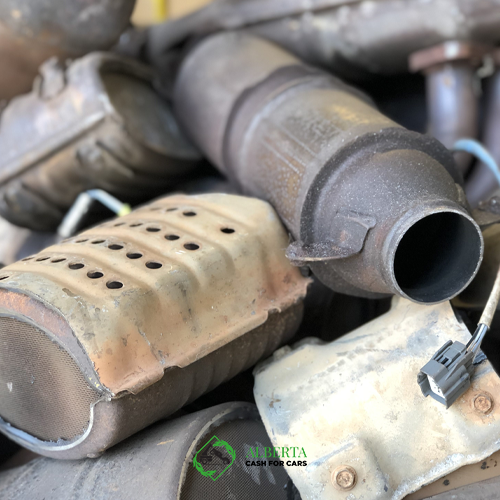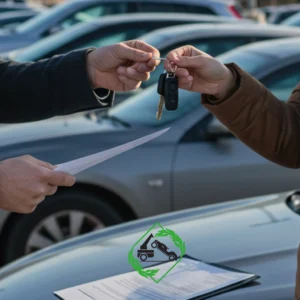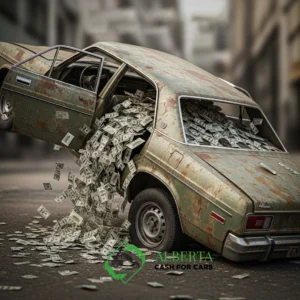Catalytic converters represent a remarkable human innovation that significantly reduces harmful emissions. It’s important to note that the materials used to make them improve performance and provide valuable materials. If you have a car that you can’t sell and are looking for solutions, consider removing the catalytic converter. Selling it as a used part may be a lucrative option for you. The scrap value of a catalytic converter varies widely, ranging from $10 to $1,100, with rare and larger models commanding higher prices.
In this article, we at Cash for Cars Calgary are going to talk about the Catalytic converter scrap value and the factors that are related to them completely, so if you want to increase your knowledge in this field, continue reading this article.
No Hassle, Just Cash — Book Your Free Pickup or Quote Today!
All you need to know about Catalytic Converters
Before catalytic converters were invented, all the exhaust fumes that were created as a by-product of the internal combustion process were directly injected into the open air. At that time, most vehicles used carburetor injection, which was not an optimal system. Also, through ineffective government regulations, leaded gasoline was used until 1996, even though unleaded gas had been readily available since 1975. All these factors led to toxic levels in cities and becoming a serious global environmental hazard.
The use of direct injection systems provided more accurate fuel management, more performance, and lower output, but this was still not enough to meet environmental standards.
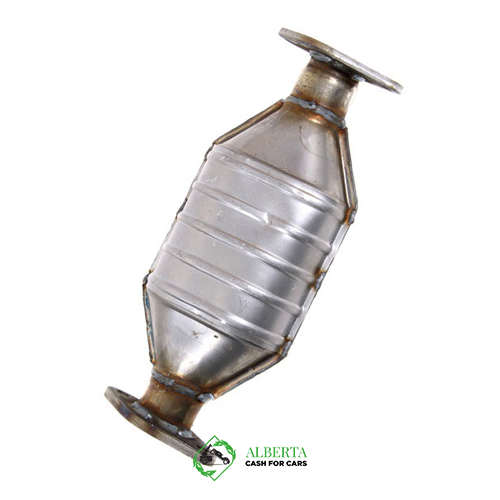
Invention of Catalytic Converters
In this situation, it was clear that some kind of exhaust filter is absolutely necessary to reduce the number of gases coming out of the exhaust system. The first examples of catalytic converters were made in parallel with the invention of the first cars, and they created the foundations of how catalytic converters work with the help of platinum, iridium and palladium in the tubular cylinder housing to filter vapors.
In the 1950s, a French mechanical engineer named Eugene Houdry made great progress in this field. He had great expertise in catalytic oil refining and was aware of the environmental hazards of unfiltered exhausts. He founded a company and invented the catalytic converter and cat converter for the first time. His first inventions were installed on the chimneys of factories, and then industrial forklifts and then cars in the mid-50s benefited from his inventions.
Catalytic converters were developed with the help of other engineers, including Carl D. Keith, Antonio Eleazar, and John J. Mooney, to the point where they could be mass produced and meet the requirements of new EPA regulations. This law stated that all vehicles since 1975 must have a two-way catalytic converter to pass the emissions test.
The purpose of two-way catalytic converters was to target carbon monoxide and unburned hydrocarbons from exhaust smoke.
How do catalytic converters work?
The operation process of catalytic converters is very easy because there are no moving parts in its body, the only thing required for chemical conversion is the presence of heat and exhaust smoke. The catalytic converter has two honeycomb meshes inside of it: one of platinum and rhodium and the other with platinum and palladium coating.
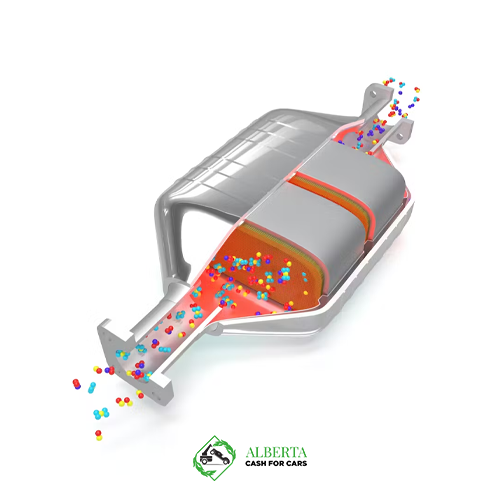
The chemical composition of exhaust smoke includes carbon oxides, nitrogen oxides and various carbon-hydrogens. When these elements enter the catalytic converter, the heat and first lattice breaks the chemical bonds to form N2, O2, CO, Co2, H2O, and CxHx. This process is called reduction.
Second honeycomb mesh intervenes in the oxidation process, resulting in N2, O2, CO2, and H2O; Compounds that are much less harmful than their original state. A 3-way catalytic converter has an efficiency rate of over 90%, which is very important for reducing emissions.
What is the Catalytic converter scrap value?
The Catalytic converter scrap value depends on various variables and factors. Whether the converter is new or used, common type or rare in the market, what metals it is made of, and other things can change its price.
But if we want to give you an average Catalytic converter scrap value, it should be said that the lowest prices are converters that usually start at 10 dollars, and those that have higher prices are 1000 dollars and above. Generally, the average prices are in the range of 30 dollars to 300 dollars. Fluctuations in the market of precious metals cause the value of catalytic converters to change every day.

How do scrap recyclers determine the Catalytic converter scrap value?
Scrap yards consider the following when they want to fix Catalytic converter scrap value:
- Converter status
- Make and model of the car
- Current prices of the rare metals market inside the cat
The catalytic converters’ types differ according to different amounts of rare metals used in their construction. The more platinum, palladium, and rhodium in the catalytic converter, the higher the value of the converter. These metals are very expensive, very rare rhodium.
The conditions of the converter also change. The better the shape, the higher the price. Scrap companies check and evaluate how much rare metals are safe and useful. If it is damaged, contaminated, and less durable, its scrap value will be lower.
The current market price plays an important role in the amount of catalytic converters received and will have a great impact on the selling Catalytic converter scrap value for you.
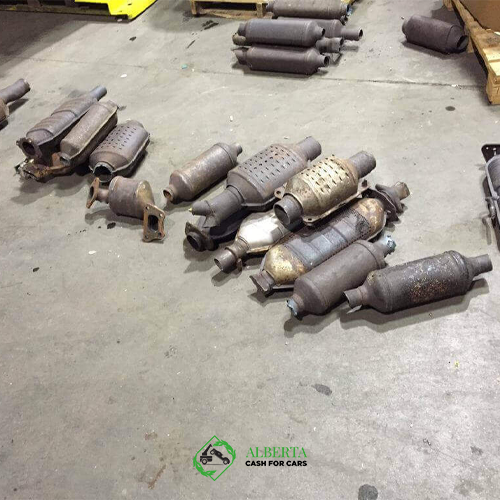
How do you check catalytic converter scrap value?
There are several different ways to check the Catalytic converter scrap value for you:
- You can check recycling websites
- Use different applications and put your converted photo in them, and get a price
- Search for used catalytic converters in the market
- Call the scrapyard or visit there
- Check catalytic converter scrap value by serial number
The easiest way to find the catalytic converter scrap value is to visit the online sites provided by recycling companies. These sites provide approximate prices for cars and cannot be said to be accurate and may not cover all models.
As a result, it is better to take another way. You can post your disguised photos on special sites and fill out their forms. The support agents of these sites will quickly read your forms, estimate the value of your catalytic converter, and send you the price.
Another idea is to check used markets for auto parts before selling them for scrap. Usually, there is a good market for used converters because they are OEM but at a cheaper price than new converters.
Contacting scrap yards or going there can be a good way to check the price, but you can search for the serial number to get the price.

Scrap Yards That Buy Catalytic Converters
When evaluating a used catalytic converter purchase, scrap yards that buy catalytic converters will examine:
- Condition: Casing must be intact with no cracks or holes. Damage indicates missing internal parts, lowering value.
- Completeness: All external pipes and heat shields must still be attached. Missing pieces lower recovery value.
- Markings: Converter casing should be stamped with codes indicating manufacturer and precious metal type. This verifies it contains recoverable metals.
- Insides: Scrap yard will visually inspect inside to ensure the honeycomb structure plate coating is present. Missing chunks lower value.
- Size: Larger converters from trucks and SUVs contain more precious metals and are more valuable than small engine converters.
By only purchasing complete, undamaged converters with original markings, scrap yards ensure they can optimize reclaimed precious metal value in the recycling process.
How to find catalytic converter scrap value by serial number?
Along with the VIN number, the serial number of the catalytic converter gives you very useful information to get the price. The only challenge is to get the serial number out of the converter because usually, most of the time, it always rings with the housing.
The good news is that there are several ways you can get the serial number. First, you need to find the seal; if it is faded, it is usually located near the O2 sensor hole. Rub the numbers in oil until they are clean and create a contrast between the housing and the etching.
If you can’t read the numbers this way, you can use a piece of steel wool to scrape off the rust and dirt and read the numbers. Just be careful to do this slowly, as the numbers may be erased.
When you find the number completely, you can find its price through one of the converter databases.
What factors affect the catalytic converter value?
The catalytic converter value can vary, ranging from $10 to $1,000. Let’s look at the factors that can increase the price of a catalytic converter value:
The composition of the expensive metal of the car affects the price of scrap catalytic converter. The market value of platinum, palladium, and rhodium constantly fluctuates, but their value is relatively high.
The condition of the scrap catalytic converter is very important, the better its maintenance, the higher the price of the catalytic converter.
The type of catalytic converter also affects its value. The gasoline converter has a higher price than the diesel catalytic converter. The difference is that the gasoline catalytic converter has more precious metals than the diesel catalytic converter.
An OEM converter and an aftermarket catalytic converter also differ in value. An OEM conversion of an aftermarket CAT is valuable because manufacturers must consider high doses of precious metals.
Because the amount of catalytic converter waste depends on its conditions, it is necessary to pay attention to its overall integrity.
Theft and Illegal Sale of Catalytic Converters
The high value of precious metals makes catalytic converters targets for theft by criminals. Thieves use battery-powered reciprocating saws to quickly cut out converters from parked vehicles. Hybrid cars like the Toyota Prius are especially popular targets given their higher precious metal loads. Once stolen, thieves sell the converters to scrap yards for a few hundred dollars each. Removing and replacing a stolen converter can cost the vehicle owner over $1000 for parts and labor based on the location.
Catalytic converter theft has surged sharply in recent years. Damage can range from $1,000 to over $3,000. Stolen converters often get sold to black market scrap dealers and smelters. It is difficult to identify and track stolen converters. Authorities are implementing tighter regulations around scrap metal sales and increasing penalties to deter thefts.
Why do thieves steal catalytic converters?
You might have heard that many thieves try to steal catalytic converters, and you might wonder what is so special about them.
FYI, thieves often steal catalytic converters to sell the metal inside them. Because this piece is made of different precious metals like platinum, palladium, and rhodium. Due to their high prices, they are very valuable in scrap markets and thieves can make a profit by selling them. Thieves sell the stolen catalytic converter in the scrap metals recycling process where they are about to recycle metals and produce new products.
The catalytic converter theft has increased in recent years because this piece can be easily removed from vehicles. After all, you should know that removing catalytic converters from vehicles can cause damage to the vehicle’s exhaust system and it’s not environment-friendly either. However, this was another reason why the catalytic converter scrap value is high for many cars and you should recycle them.
Protecting Your Catalytic Converter Value
Vehicle owners can take measures to deter converter thieves:
- Install security devices like protective cages or cables around the converter to make it harder to remove.
- Engrave the vehicle’s VIN number onto the converter to help identify it if stolen.
- Install alarm systems to alert you to potential tampering.
- Park in well-lit areas covered by video surveillance when possible.
- Have the converter welded to the vehicle’s frame or exhaust system.
- Register your converter with theft tracking databases to aid recovery.
Selling Scrap Catalytic Converters
To legally sell your scrap catalytic converter value:
- Contact reputable metal recycling facilities to request quotes and arrange sale.
- Provide details like converter brand, vehicle type, engine size to assess the value.
- Have documentation to prove legal ownership of the converter being sold.
- Exercise caution when third parties offer unsolicited quotes or cash for converters as these may signal illegal schemes.
When should you get a new catalytic converter?
Here are some signs that you need a new catalytic converter:
- Odometer reading: When your odometer reaches 100,000 miles you should take a mechanical look at your catalytic converter as it may be nearing the end of its life.
- Rattling sound: Rattling sound while driving may indicate structural damage.
- Fuel inefficiency: The condition of the converter has an effect on engine performance and fuel inefficiency. A damaged converter can affect the acceleration of the car. If your car uses more fuel than usual or slows down significantly, it’s time to consult a mechanic.
- Bad odor: Be aware of the bad smell in your exhaust pipe, after all, the main function of the catalytic converter is to clean the exhaust fumes like nitrogen oxides. If expensive catalytic converters are damaged, you probably have no choice, but if it’s time to get rid of your old catalytic converter, selling it can help offset the cost of a new one.
Many people sell their old catalytic converters to scrap yards that need to be prepared.
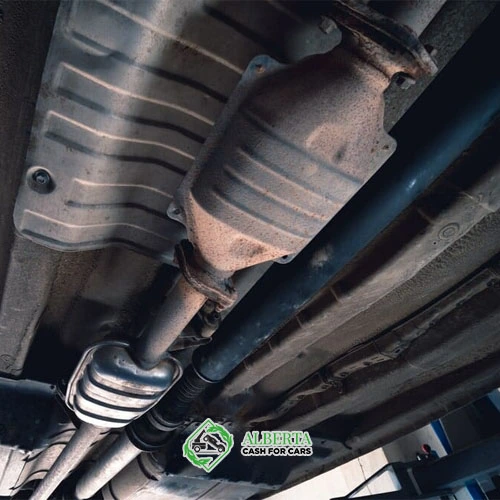
Importance of recycling catalytic converters
Recycling catalytic converters holds paramount importance in both environmental conservation and the sustainable utilization of valuable resources. The phrase “catalytic converter value” not only embodies the economic significance of these components but also reflects their critical role in reducing harmful emissions from vehicles.
The ecological impacts of catalytic converters, involving platinum, palladium, and rhodium along with other precious metals, are the central concern. These metals work as catalysts, enabling chemical reactions to transform the dangerous toxins that cars release into less dangerous ones. Undoubtedly, the catalytic converter plays a crucial role in the worldwide effort to reduce air pollution because of its capacity to lessen the negative environmental effects of vehicle emissions.
To fully use the catalytic converter value found in these precious metals, recycling catalytic converters is essential. The need for newly mined metals is decreased by recovering and repurposing platinum, palladium, and rhodium from outdated or broken converters. This reduces the environmental impact of the sometimes-intensive extraction methods while simultaneously conserving natural resources.
Moreover, recycling catalytic converters contributes to the circular economy, wherein materials are reused, reducing the need for continuous extraction and production of new components. This circular approach ensures that the catalytic converter value is sustained over time, creating a more sustainable and responsible automotive industry.
The value of a catalytic converter extends beyond the instantaneous recycling procedure from an economic standpoint. Recycling facilities and scrap yards are essential links in the supply chain for precious metals because they rescue and reuse these valuable commodities. Besides fulfilling the market wants for these metals, the recycling sector’s capacity to recover and process catalytic converters also contributes to price stability.
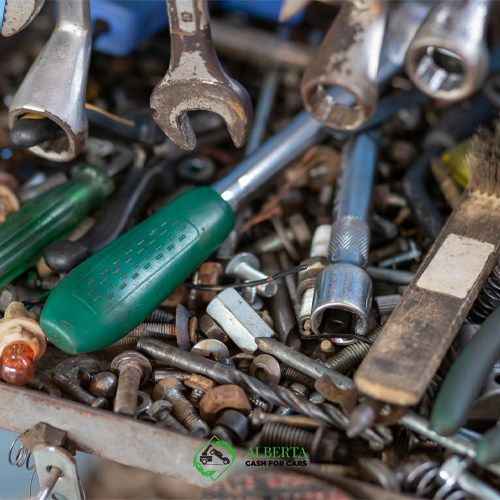
Catalytic converter recycling is significant for reasons more than just economics. It is an essential procedure that protects the environment, preserves important resources, and actively works to lessen the negative consequences of vehicle emissions. Understanding the benefits of catalytic converter recycling is essential to creating a more environmentally conscious and sustainable automobile industry.
The Catalytic Converter Recycling Process
Once scrap yards that buy catalytic converters, purchase old catalytic converters, they are sent to specialty recycling facilities to reclaim the precious metals inside. Workers first dismantle the external housing and components for sorting. The inner honeycomb structure goes into a hammer mill for crushing into a powder. This releases the platinum, palladium, and rhodium particles which are then separated and concentrated through various chemical baths and smelting processes.
The recycled precious metals are sold to refiners and traded on commodity markets. Rhodium is especially scarce, so recycling plays a key role in supplying adequate rhodium for industrial needs. While catalytic converters are intended to reduce emissions, recovering their metals also reduces the need for destructive mining. Recycling converters is estimated to reduce carbon emissions by 13 kg for every 1 kg of platinum recovered. Overall, the recycling chain allows these precious resources to be reused rather than discarded.
What cars have the most catalytic converter value?
Sports cars and trucks usually have the most expensive catalytic converter value. These cars have bigger and more powerful engines than other vehicles, which means they produce more emissions, so their catalytic converters have to work better to achieve the same amount of emissions reduction. Also, sports cars usually have an aggressive driving style that can put pressure on the exhaust system and lead to frequent repairs and replacements.
There are several car models whose catalytic converters are worth more when scrapped. The most expensive cars whose catalytic converter is scrapped include the following:
- Lamborghini Aventador
- Porsche 911 Turbo S
- Ferrari F430
The most catalytic converter value is the Ferrari F430, which had a strange price tag of $3,700. Also, because the Ferrari F430 needed two of them, a complete replacement will cost owners $7,500 before taxes.
While the Lamborghini Aventador catalytic converter is the second most expensive with a price of $3,120, it still requires two converters like the previous one. This brings the total replacement cost to about $6,200.
The third one is not as unusual as a Lamborghini or a Ferrari, but it is still relatively expensive. This is the Porsche 911 Turbo S, which has a price tag of $3,400.
Final words
The catalytic converter is an important part of the car because it cleans harmful exhaust gases and also protects the car engine from wear and tear and ensures its performance for years to come. We hope that in this blog, we have been able to help you with the importance and value of these converters and have answered your main questions.

